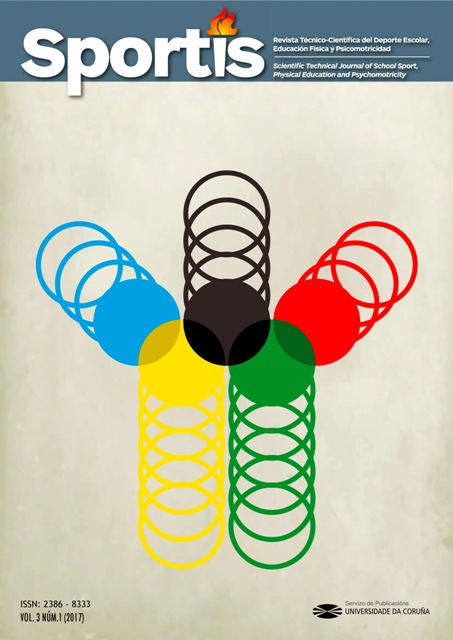The effective time measurement of physical education and its impact on caloric expenditure at primary schoolchildren level Municipality of Colima, Mexico
Main Article Content
Abstract
The aim of this research was to measure the effective time of physical education and its impact on caloric expenditure. The population was composed by 189 subjects of Mexican schools. They were intentionally selected from the ranking quality of the Ministry of Education of the State of Colima, Mexico. The instruments used were the questionnaire Observing System and Fitness Instruction Time and pedometers, model W2-GN SBB0. Among the most relevant results it shows that 35.10% of the class students remain standing and 28% of the class does not perform motor activities. Regarding the role of the teacher 27.80% of the time is dedicated to observe the class and 26.40% is outside the work area. In relation to the average caloric expenditure was 164.21 ± 59.18. Significant differences (p = .000) between schools were identified, and the position in the ranking (p = .804). In conclusion: the level of physical activity during the sessions is insufficient in relation to international standards, as well as the national program, which requires an increase motor performance, over the time spent on classroom management.
Keywords:
Downloads
Article Details
References
American Heart Association (2006). Centers for desease control and prevention, national center for chronic disease prevention and health promotion. Obtenido de Promoting better health for young people throug physical activity and sport: a report to the president from the secretary of health and human services and the secretary of education. Recuperado de: http://www.cdc.gov/nccdphp/dash/presphysactrpt
Arias, R. (2015). Análisis comparativo del número de pasos mediante el uso del podómetro y su relación con el nivel de actividad física que realizan los estudiantes de primero de bachillerato electrónica de la Unidad educativa fiscomisional Don Bosco de la Tola, Ecuador. Recuperado de: http://www.dspace.uce.edu.ec/bitstream/25000/4473/1/T-UCE-0016-015.pdf (T-UCE-0016-015).
Arufe-Giráldez, V., Abelairas-Gómez, C., Barcala-Furelos, R. y Teixeira-Costa, H. J. (2015). The influence of a structured physical education plan on preschool children’s psychomotor development profiles. Australian Journal of Early Childhood, 40 (2), pp.68-77.
Atlantis, E., Barnes y Fiatarone-Singh, M. (2006). Efficacy of exercise for treating overweight in childrenand adolescents: a systematic review. International Journal of Obesity, 30, 1027–1040.
Bastos, A., González-Boto, R. y Molinero-González, A. (2005). Obesidad, nutrición y actividad física. Revista Internacional de Medicina y Ciencias de la Actividad Física y el Deporte. 5 (18) pp. 140-153.
Dirección General de Educación Física. (2006). Programa de Educación Física. Secretaría de Educación Pública.
Feu, S., Salazar, C., Antúnez, A. y De la Cruz, E. (2016). La Educación Física como parte de la solución al avance de la plaga de la obesidad en la edad escolar. En: Libro de Actas del 4th International Congress of Educational Sciences and Development. Pág. 501. Universidad de Granada. ISBN: 978-84-608-9269-4.
FIEP. (2015). Manifiesto Mundial de Educación Física 2015. San Luis Potosí, México.
García, E., Antonio, J. y Morillas, P. (2010). Las pérdidas de tiempo en las clases de educación física del tercer ciclo de educación primaria. Efderpotes, 14-141. Recuperado de: http://www.efdeportes.com/efd141/las-perdidas-de-tiempo-en-educacion-fisica.htm
Hall, J., Ochoa, P., Chávez, C., Alarcón, I., Sáenz-López, P., Muñoz, G. y Reyes, J. (2012). Evaluación de la intensidad y contexto de la clase de educación física antes y después de una capacitación a estudiantes de licenciatura en actividad física y deporte de la UABC. Wanceulen: Educación Física Digital (9), 1-8.
ISAK. (2001). Estándares internacionales para la valoración antropométrica: Sociedad Internacional para el Avance de la Kinantropometría.
Kirk, D. (2009). Physical education futures. USA:Routledge.
Kobel, S., Kettner, S., Erkelenz, N., Kesztyus, D. y Steinacker, J. M. (2015). Effects of Physical Education on Objectively Determined Physical Activity in Primary School Children-Which Proportioning Is Best? Journal of Teaching in Physical Education, 34(3), 537-547.
Meyer, U., Roth, R., Zahner, L., Gerber, M., Puder, J.J., Hebestreit, H. y Kriemler, S. (2013). Contribution of physical education to overall physical activity. Scandinavian Journal of Medicine & Science in Sports, 23(5), 600-606.
McKenzie, T. L., Sallis, J. F., & Nader, P. R. (1991). System for observing fitness instruction time. J Teach Phys Educ, 11, 195-205.
Moreno, L., Concha, F. y Kain, J. (2012). Intensidad de movimiento de escolares durante clases de educación física de colegios municipales: resultados según el profesional que efectúa las clases. Revista chilena de nutrición, 123-128.
Pate, R.R., Davis, M.G., Robinson, T.N., Stone, E.J., McKenzie, T.L. y Young, J.C. (2006). Promoting Physical Activity in Children and Youth: A Leadership Role for Schools: A Scientific Statement From the American Heart Association Council on Nutrition, Physical Activity, and Metabolism (Physical Activity Committee) in Collaboration With the Councils on Cardiovascular Disease in the Young and Cardiovascular Nursing. Circulation, 114(11), 1214-24.
Pons, R. y Arufe, V. (2015). Análisis descriptivo de las sesiones e instalaciones de psicomotricidad en el aula de educación infantil. Sportis. Scientific Journal of School Sport, Physical Education and Psychomotricity, 2(1), 125-146.
Siedentop, D. (1998). Aprender a enseñar la Educación Física. Barcelona: INDE.
Teixeira, H. J., Abelairas-Gómez, C., Arufe-Giráldez, V., Pazos-Couto, J. M. y Barcala-Furelos, R. (2015). Influence of a physical education plan on psychomotor development profiles of preschool children. Journal of Human Sport and Exercise, 10(1), 126-140.
Travieso, C. J. y Pavón, J. E. (2006). Valoración de la utilización del tiempo en las clases de educación física de tercer grado en el municipio Las Tunas. Efdeportes.com 1-Recuperado de: http://www.efdeportes.com/efd100/tiempo.htm
UNESCO. (2015). Educación Física de Calidad. Francia:Unesco.
Zorrilla-Arena, S. (1999). Introducción a la metodología de la investigación. En: S. Zorrilla-Arena. Introducción a la metodología de la investigación. México, D.F.: Cal y Arena.
WHO. (12 de agosto de 2009). Physical activity and health. Recuperado de: http://www.who.int/dietphysicalactivity/pa/en/index.html
World Medical Association (WMA). (2000). Declaración de Helsinki para la investigación con seres humanos. [sede Web]. Voltaire, Francia: WMA; Recuperado de: http://www.wma.net/s/policy/b3.htm.






